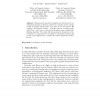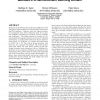23 search results - page 3 / 5 » Evolving neural networks for fractured domains |
GECCO
2010
Springer
13 years 10 months ago
2010
Springer
The Hypercube-based NeuroEvolution of Augmenting Topologies (HyperNEAT) approach demonstrated that the pattern of weights across the connectivity of an artificial neural network ...
GECCO
2007
Springer
13 years 12 months ago
2007
Springer
Adaptive representations allow evolution to explore the space of phenotypes by choosing the most suitable set of genotypic parameters. Although such an approach is believed to be ...
GECCO
2007
Springer
13 years 12 months ago
2007
Springer
Connectivity patterns in biological brains exhibit many repeating motifs. This repetition mirrors inherent geometric regularities in the physical world. For example, stimuli that ...
SEAL
1998
Springer
13 years 10 months ago
1998
Springer
Abstract. Robustness has long been recognised as a critical issue for coevolutionary learning. It has been achieved in a number of cases, though usually in domains which involve so...
GECCO
2006
Springer
13 years 9 months ago
2006
Springer
Both genetic algorithms (GAs) and temporal difference (TD) methods have proven effective at solving reinforcement learning (RL) problems. However, since few rigorous empirical com...


